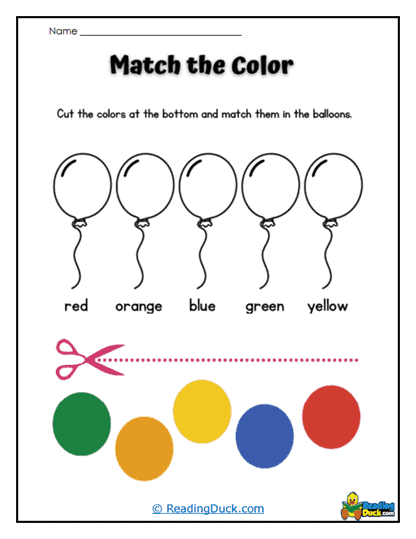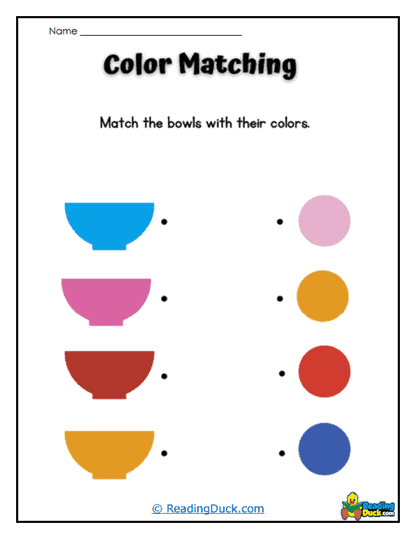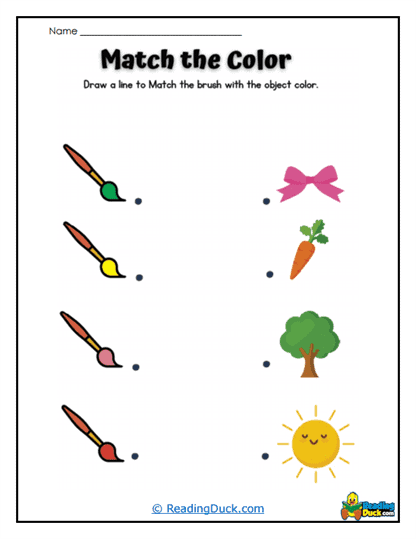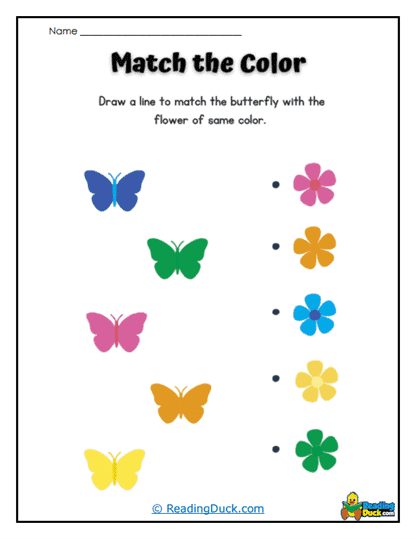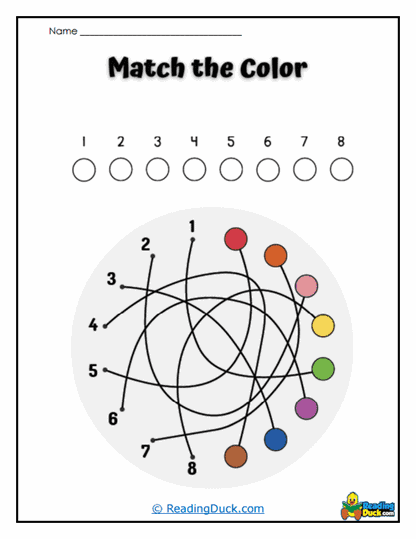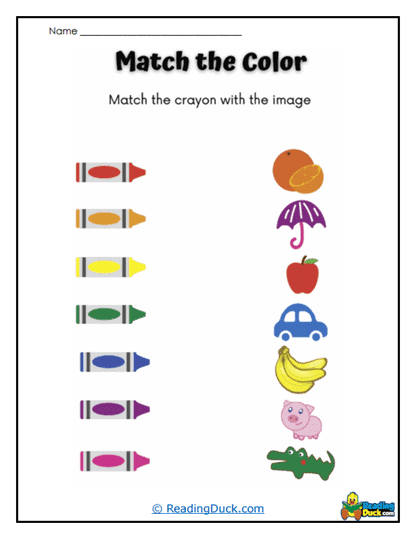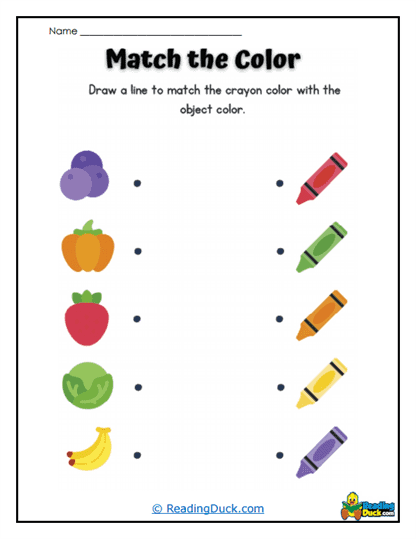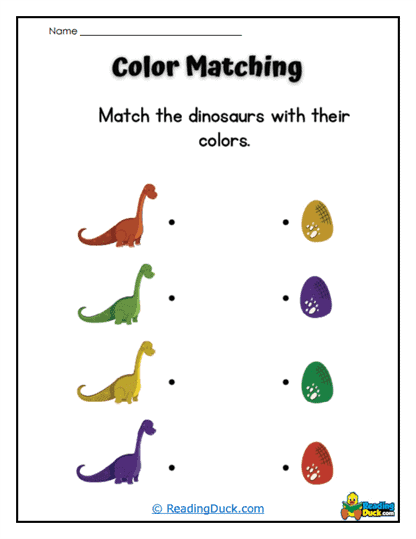Learning Colors Worksheets
About Our Learning Colors Worksheets
These worksheets focus on helping children recognize, identify, and associate different colors with familiar objects from their surroundings, aiding their visual and cognitive development. Through colorful images and relatable themes, these worksheets create an enjoyable learning experience. They don't just teach colors-they turn learning into a playful adventure where each page is filled with colors that bring familiar objects to life. These worksheets are thoughtfully designed to help children recognize, identify, and associate various colors with objects they encounter in their everyday surroundings, supporting both visual and cognitive growth. By making color recognition a fun and engaging task, these worksheets help establish a solid foundation for further learning, easing children into a school routine. When children enjoy what they're doing, they're more likely to engage deeply, making these worksheets an ideal way to foster curiosity and joy in learning from an early age.
In this collection, each exercise creatively uses familiar items like fruits, animals, clothing, and household objects to introduce color recognition in a natural, relatable way. By linking colors to everyday items, children develop the ability to connect learning materials with their real-world experiences, which enhances their understanding and memory. For example, a bright yellow banana or a red apple on the page becomes a simple, intuitive way for children to link color to vocabulary, cementing these connections over time. The worksheets are crafted to appeal visually, with each page showcasing eye-catching illustrations that feel familiar and welcoming. This approach not only helps with color identification but also makes learning a positive, enjoyable experience, leaving children excited for the next activity.
The main purpose of these worksheets is to gently introduce children to the world of colors in a structured yet friendly way. They encourage young learners to explore and describe the world through colors, building an essential cognitive skill that aids in developing both language and observational abilities. By linking each color to a specific object, children start to see color as a descriptive tool, an early step toward understanding adjectives and descriptive language in general. This linkage strengthens a child's vocabulary, enabling them to communicate about their environment more precisely and confidently. Over time, this foundational skill becomes an essential part of their language development, setting them up for success in reading and verbal communication.
With these worksheets, educators and parents can transform color learning into a playful activity that doesn't feel like a chore, helping children see learning as an exciting adventure. The playful nature of these tasks encourages sustained attention, allowing children to stay focused and engaged, even with prolonged activities. Each completed worksheet boosts a child's confidence, as they experience the joy of mastery in recognizing and naming colors. This sense of accomplishment fuels further curiosity, empowering children to explore and articulate the colors and objects in their surroundings. As they progress, they build a sense of independence and pride in their learning journey, creating a strong foundation for future educational experiences.
Student Tasks
The activities in these worksheets encompass various tasks that help children practice color identification and matching. Each task is designed to provide a unique challenge, stimulating both their problem-solving and fine motor skills. Here are some examples:
Matching Colors with Objects
Many worksheets use a simple yet effective exercise where children draw lines from colored crayons or blocks to items that match the color, such as connecting a red crayon to an apple or a yellow one to a banana. This task doesn't just help with color recognition-it strengthens the connection between colors and real-world objects, building familiarity and comfort with the colors they see every day. By associating colors with familiar items, children begin to develop early categorization skills, as they mentally group similar objects based on color. This activity also encourages autonomy; as children practice matching on their own, they start to identify colors independently, a key step in building self-confidence in learning. Teachers can observe how students are progressing in both color recognition and attention to detail, offering additional support to those who may need it while celebrating the accomplishments of those who succeed.
Color Sorting and Association
Some worksheets add a tactile element by including cut-and-paste activities where children cut out colored shapes or objects and paste them next to items of the same color. This hands-on activity goes beyond just color recognition, as it involves coordination and focus, helping children develop essential fine motor skills. Cutting and gluing not only reinforce hand-eye coordination but also give children a sense of control and accomplishment as they manipulate objects to create a completed picture. Through these physical interactions, children start to understand the concept of association-learning that colors and objects can be connected based on similarity. For teachers, this exercise is an opportunity to monitor each child's fine motor development and spatial awareness, adapting activities as needed to ensure all children find success and enjoyment.
Pattern and Set Matching
In certain worksheets, students are asked to match items by color patterns, such as pairing flip-flops with shirts of the same color or design. This activity takes color recognition to the next level by introducing the concept of patterns, an early math skill, as children learn to identify and replicate color sequences. Recognizing patterns fosters logical thinking and attention to detail, as children carefully observe the colors and designs in order to make correct matches. This activity also helps children become more observant, noticing details and relationships between items, which is an essential skill for reading and other subjects. For teachers, pattern matching is a fantastic way to introduce early math concepts in a creative, non-intimidating way, sparking a natural curiosity about how colors and patterns relate in everyday life.
Connecting Lines and Coloring Within Outlines
Drawing lines between colors and their matching items, or coloring within outlines, challenges children to focus on hand control and accuracy, which are crucial skills for writing and other fine motor tasks. This kind of task teaches patience and precision, as children learn to direct their movements with purpose, ultimately building hand strength and coordination. Coloring within the lines, especially, gives children a sense of boundaries, teaching them to respect guidelines while creatively expressing themselves within those limits. This exercise is ideal for teachers aiming to prepare young learners for writing activities, as it builds the muscle memory and control necessary for gripping and maneuvering a pencil. Plus, it's a fun, calming activity that many children find rewarding, especially when they successfully stay within the lines or connect objects accurately.
Each task builds a different aspect of cognitive and motor development, using color as a consistent theme. These diverse activities keep children engaged, preventing them from feeling repetitive, and ensure that children practice color recognition through multiple learning styles.
Skills Developed
These worksheets are not only about color recognition. They also develop a range of cognitive, motor, and social skills essential for early education. Here's a breakdown of some key skills children acquire:
Color Recognition
The primary skill developed through these worksheets is color identification, which is a foundational visual skill that allows children to start “seeing” their world in a more organized way. Recognizing and differentiating colors isn't just fun-it sharpens a child's visual discrimination abilities, helping them to notice even subtle differences between hues and shades. This skill of color recognition becomes an essential building block for advanced cognitive processes, such as sorting, grouping, and classifying objects. As children become adept at identifying colors, they start forming connections that lay the groundwork for understanding complex patterns in math and language, like grouping by similarity or contrast. Teachers can use these exercises as opportunities to reinforce vocabulary, as children learn to describe objects in more detail and accuracy, enhancing their expressive language skills.
By practicing these skills in a colorful, playful way, children gain confidence in their ability to complete tasks accurately and independently. These worksheets offer a scaffolded approach, supporting children as they build from basic recognition to more complex skills like pattern recognition and logical grouping.
Fine Motor Skills
Tasks like drawing lines, cutting out shapes, and gluing pieces do much more than keep little hands busy-they actively strengthen the fine motor abilities essential for early childhood development. These exercises are critical for developing the hand-eye coordination necessary for tasks like writing, as they involve controlled, precise hand movements. By practicing control over small hand movements, children gain familiarity with managing tools like pencils, crayons, and scissors, which are essential in later academic activities. These worksheets provide children with multiple forms of practice that help them build confidence with fine motor tasks in an enjoyable, low-stress way. For teachers, this is a great chance to observe each child's development in dexterity and hand control, making note of students who may need extra support or modified activities to build strength and coordination.
Problem-Solving and Categorization
Sorting items by color is an engaging yet purposeful task that requires logical thinking and categorization, both of which are essential problem-solving skills for young children. When children categorize objects by color, they are learning a key cognitive skill that underpins later concepts in math and science, where categorization and logical reasoning come into play frequently. By engaging in color-matching and sorting tasks, children begin to understand basic concepts of grouping and organizing, which builds a foundation for more advanced learning. Teachers can use these exercises to discuss “why” objects might be sorted in certain ways, encouraging critical thinking and reasoning as children consider the characteristics that make items similar or different. This approach not only enhances cognitive development but also boosts children's confidence in making decisions independently, a skill that benefits them across various subjects.
Attention to Detail
Staying within the lines while coloring or ensuring the correct color matches build a child's attentiveness and concentration-skills that are essential for academic success and personal growth. These tasks encourage children to focus, take their time, and pay attention to small details, teaching them that careful work has its rewards. Attention to detail is a valuable skill that fosters patience and precision, and it's something that will benefit children in many areas beyond art, such as reading, math, and science. Teachers can observe how children approach these tasks, noting who naturally takes time to focus and who might need extra encouragement or practice. Over time, these exercises help instill a sense of pride and accomplishment, as children see the results of their focused work, setting the stage for a positive approach to all kinds of learning.
The Importance of These Worksheets
These worksheets are invaluable tools for early educators and parents because they lay the groundwork for essential learning skills in young children. Here's why this collection is a must-have resource:
Foundational Learning
Recognizing and identifying colors is one of the earliest cognitive skills children develop, serving as a key building block in their understanding of the world. Learning colors is more than just a fun activity; it enriches their descriptive language abilities, helping them label, organize, and articulate their environment with greater confidence. When children learn to identify colors, they're taking their first steps into categorization, a skill essential for complex cognitive tasks, such as sorting, pattern recognition, and even early math concepts. This foundational learning supports later academic skills in subjects like science, where they will need to distinguish and group items by characteristics. For teachers, these early color lessons are an invaluable way to introduce young learners to structured learning in a fun, accessible way that sets them up for future success.
Engagement and Motivation
Colorful, visually stimulating worksheets capture children's interest in ways that traditional exercises often can't, turning the learning process into an adventure rather than a task. These worksheets use familiar themes-like animals, fruits, and household items-to make each page relatable and comforting, holding a child's attention and making them eager to participate. When children are engaged, they absorb information more naturally, and this active participation leads to a deeper understanding and retention of what they're learning. Engaging worksheets foster a positive attitude toward learning, which is critical as children form their first impressions of education and school. For teachers, these resources make classroom management easier, as motivated children are more likely to stay focused and enthusiastic about their learning journey.
Preparatory Skills for Further Learning
By combining cognitive, language, and motor skills, these worksheets prepare children for more advanced subjects and lay the groundwork for academic success. Color matching and sorting are not just about colors; they introduce children to basic math concepts like grouping and categorizing, which will later evolve into skills needed for counting, measuring, and understanding patterns. Similarly, tasks requiring fine motor skills, such as drawing lines and coloring within shapes, are the precursors to writing skills, building hand strength, and coordination. These foundational skills ensure that when children progress to more structured classroom settings, they have the attention span, coordination, and focus needed to succeed. Teachers can view these worksheets as a bridge to formal education, where each task completed is a step closer to developing readiness for reading, writing, and arithmetic.
Cultural and Contextual Relevance
Using everyday items like fruits, animals, and household objects in these worksheets makes the learning experience highly relatable, allowing children to see their world reflected in their studies. This familiarity helps children feel at ease, as they recognize objects they know, which in turn reinforces the connection between learning materials and real life. By linking classroom learning with the home environment, these worksheets make learning culturally relevant, strengthening children's understanding that what they learn in school is applicable to their everyday experiences. This approach also helps children from diverse backgrounds, as they find common ground in universally recognizable objects, creating an inclusive learning environment. For teachers, these worksheets serve as a gentle reminder to keep lessons relevant and relatable, bridging the gap between the classroom and the outside world in meaningful ways.

